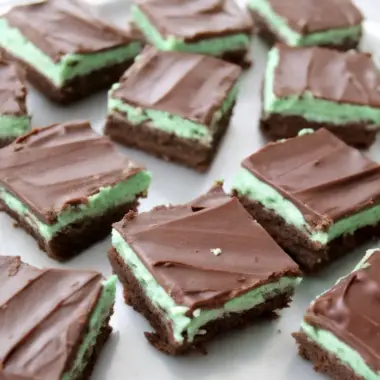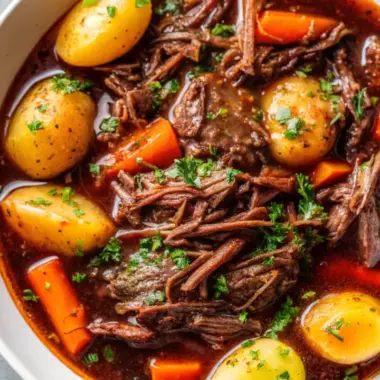Did you know that 78% of home cooks consider prime rib a “special occasion only” dish because they’re intimidated by the cooking process? Yet, with the right prime rib roast oven technique, you can create a mouthwatering centerpiece that rivals any high-end steakhouse. The secret lies not in complicated methods, but in understanding the simple science of heat and timing. Whether you’re hosting a holiday feast or celebrating a milestone, mastering the perfect prime rib roast in your oven is easier than you think.
Ingredients for the Ultimate Prime Rib Roast
What transforms a good prime rib into an extraordinary one? It’s all about quality ingredients and proper seasoning. Here’s what you’ll need for a show-stopping 4-5 pound prime rib roast:
- 1 (4-5 lb) bone-in or boneless prime rib roast (ask your butcher for first cut, ribs 10-12)
- 2 tbsp olive oil or softened butter (creates a beautiful crust)
- 1 tbsp kosher salt (the larger crystals help form the perfect crust)
- 1 tbsp freshly cracked black pepper (freshly cracked provides the best flavor)
- 2 tsp garlic powder (for depth of flavor)
- 1 tsp onion powder (adds subtle sweetness)
- 1 tbsp fresh rosemary or thyme (optional, but highly recommended for aromatic complexity)
Optional flavor boosters:
- 4 garlic cloves, halved (for inserting into the roast)
- 1 onion, sliced (creates a natural roasting rack)
Pro tip: For the best results, choose a roast with good marbling and a generous fat cap, which will baste the meat as it cooks.
Timing: How Long Does Prime Rib Take to Cook?
Understanding the timing for your prime rib roast oven process is crucial for perfect results:
- Preparation time: 15 minutes (plus 1-2 hours for bringing to room temperature)
- Cooking time: Approximately 1.5-2 hours (depending on desired doneness)
- Resting time: 25-30 minutes (non-negotiable for juicy results)
- Total time: About 3-4 hours from start to finish
Here’s a helpful guide for cooking times based on weight:
- 4-5 lb roast: 1.5-2 hours total
- 6-7 lb roast: 2-2.5 hours total
- 8-10 lb roast: 3-3.5 hours total
Remember: These times are estimates. Always use a meat thermometer for precision.
Step-by-Step Instructions for Perfect Prime Rib
Step 1: Prepare Your Roast
Remove the prime rib from the refrigerator 1-2 hours before cooking. This ensures even cooking throughout. Pat the roast completely dry with paper towels—this is crucial for achieving that perfect crust.
Step 2: Season Generously
Rub the entire surface of the roast with olive oil or softened butter. In a small bowl, combine kosher salt, black pepper, garlic powder, and onion powder. Massage this seasoning blend all over the roast, making sure to coat all sides evenly. If using fresh herbs, gently press them into the meat.
Step 3: Sear for Flavor
Preheat your oven to 450°F (230°C). Place the seasoned roast fat-side up on a rack set in a roasting pan. For extra flavor, scatter sliced onions on the bottom of the pan to create a natural roasting rack. Roast uncovered for 20 minutes to develop a beautiful, caramelized crust.
Step 4: Slow Roast to Perfection
Reduce the oven temperature to 325°F (165°C). Continue roasting until the internal temperature reaches:
- Rare: 120-125°F (bright red center)
- Medium-Rare: 130°F (warm red center) – recommended for best flavor and juiciness
- Medium: 135-140°F (pink center)
Plan for approximately 15-20 minutes per pound, but always use a meat thermometer for accuracy.
Step 5: Rest Before Slicing
Transfer the roast to a cutting board and tent loosely with foil. Let it rest for 25-30 minutes—this allows the juices to redistribute throughout the meat. Don’t skip this step, as it’s essential for a juicy result!
Step 6: Carve and Serve
If your roast is bone-in, carve the bones away from the meat first. Then, slice the prime rib across the grain into ½-1 inch thick slabs. Drizzle with the resting juices for extra flavor.
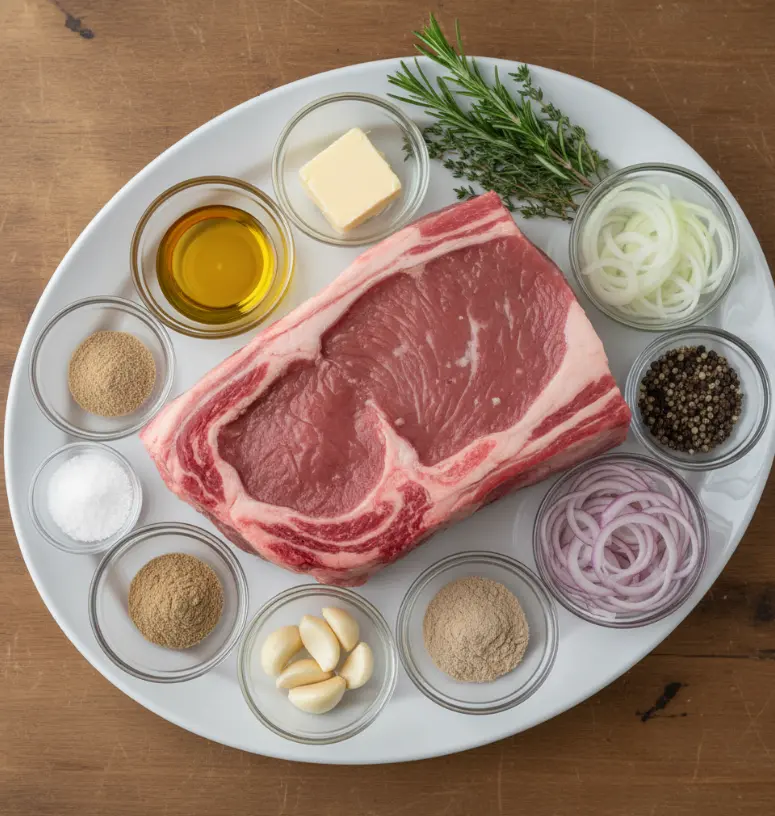
Nutritional Information (per 4 oz serving)
| Nutrient | Amount |
|---|---|
| Calories | 330 kcal |
| Protein | 28g |
| Fat | 24g |
| Saturated Fat | 10g |
| Cholesterol | 85mg |
| Sodium | 620mg |
| Iron | 15% DV |
Note: Nutritional values are approximate and may vary based on specific ingredients and portion sizes.
Healthier Alternatives and Modifications
While prime rib is inherently rich, you can make it slightly healthier without sacrificing flavor:
- Leaner Cut Option: Choose a boneless roast and trim visible fat before cooking.
- Herb Crust: Replace some of the salt with fresh herbs like rosemary, thyme, and oregano.
- Reduced Sodium: Use a low-sodium seasoning blend and fresh garlic instead of garlic powder.
- Portion Control: Serve smaller portions (3-4 oz) with plenty of roasted vegetables.
- Alternative Cooking Method: Try reverse searing for more even cooking and better fat rendering.
For dietary restrictions:
- Keto-Friendly: This recipe is naturally low in carbs.
- Gluten-Free: All ingredients are naturally gluten-free.
- Dairy-Free: Use olive oil instead of butter.
Serving Suggestions to Impress Your Guests
Transform your prime rib roast into a complete feast with these serving ideas:
- Classic Pairings:
- Creamy horseradish sauce
- Rich au jus made from pan drippings
- Creamed spinach or creamed corn
- Modern Twists:
- Chimichurri sauce for a fresh, herby contrast
- Roasted garlic mashed cauliflower instead of traditional potatoes
- Balsamic-glazed roasted vegetables
- Wine Pairings:
- Full-bodied reds like Cabernet Sauvignon or Malbec
- For white wine lovers, a buttery Chardonnay
- Leftover Makeovers:
- Prime rib sandwiches with caramelized onions
- Prime rib hash with potatoes and peppers
- Beef and barley soup
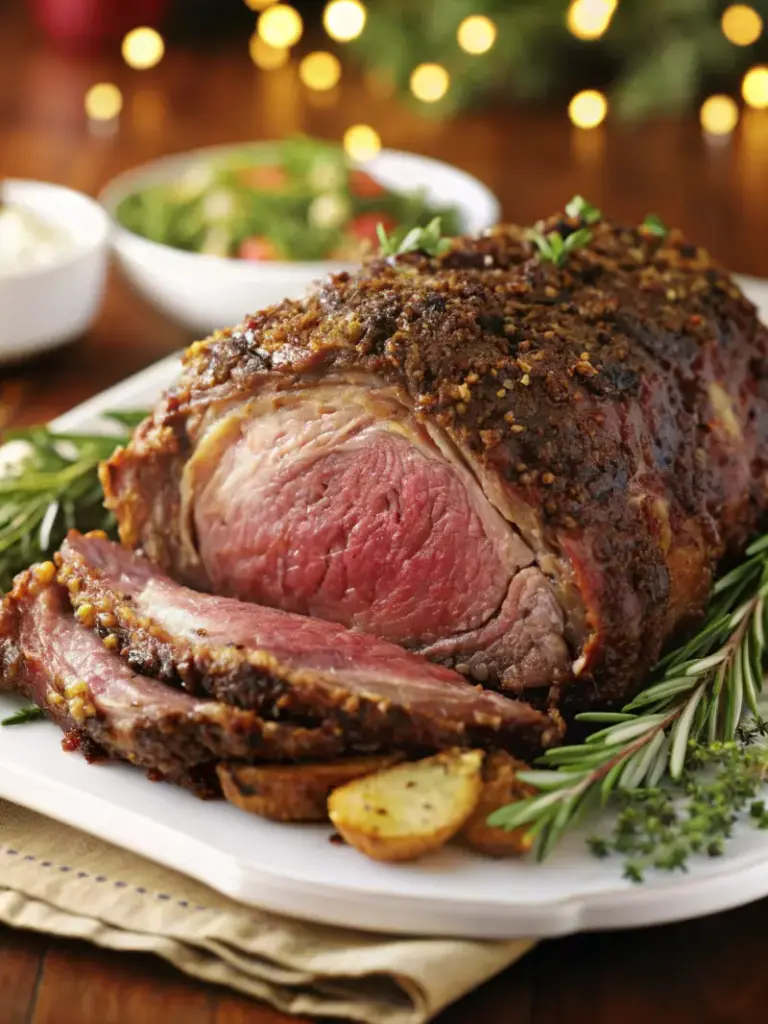
Common Mistakes to Avoid
- Not Bringing Meat to Room Temperature: This leads to uneven cooking.
- Skipping the Sear: The initial high heat creates that coveted crust.
- Overcooking: Use a meat thermometer religiously.
- Skipping the Rest: This results in dry meat as juices escape.
- Wrong Pan Size: Use a roasting pan that’s not too big or too small.
Pro tip: Invest in a good quality instant-read thermometer—it’s the most important tool for perfect prime rib.
Storing and Reheating Tips
To maintain optimal quality:
- Refrigeration:
- Store leftovers within 2 hours of cooking
- Place in airtight containers
- Consume within 3-4 days
- Freezing:
- Wrap tightly in plastic wrap and foil
- Label with date
- Use within 2-3 months for best quality
- Reheating:
- For best results, reheat slices in a 250°F oven until warmed through
- Add a splash of beef broth to prevent drying
- Avoid microwaving, which can make the meat tough
Conclusion: Your Path to Prime Rib Perfection
Mastering the perfect prime rib roast in your oven is an achievable goal that will impress family and friends at any gathering. By following these steps—proper seasoning, precise cooking temperatures, and adequate resting time—you’ll create a tender, juicy masterpiece every time. Remember, the key to success lies in quality ingredients, patience, and using a reliable meat thermometer.
Ready to create your own restaurant-quality prime rib? Try this recipe for your next special occasion and share your results in the comments below! Don’t forget to subscribe for more foolproof recipes and cooking tips delivered straight to your inbox.
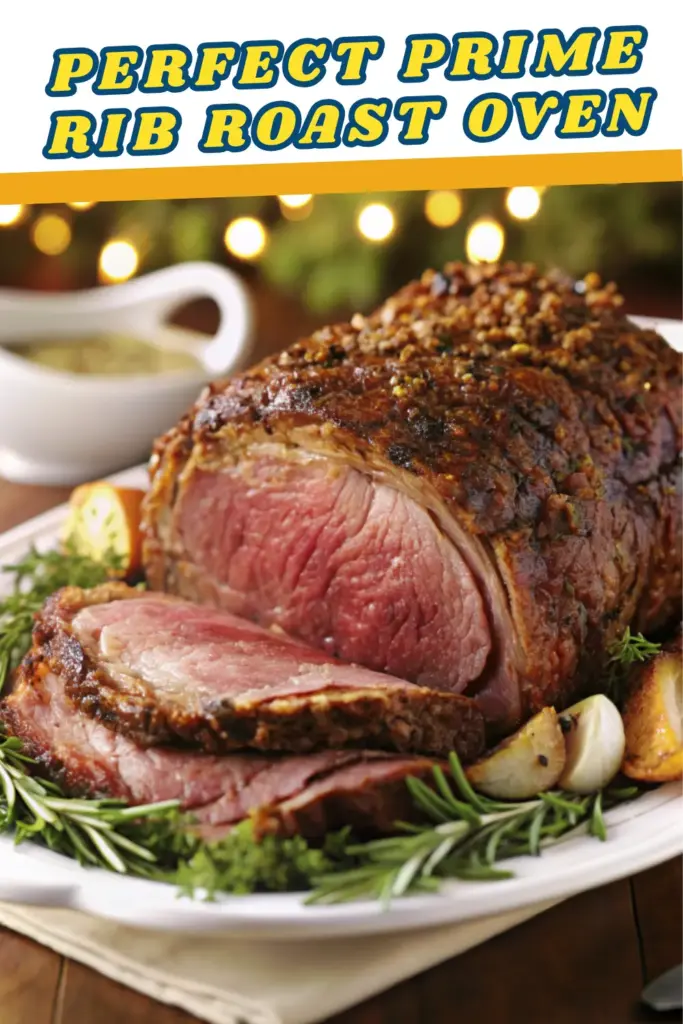
Frequently Asked Questions
Q: Can I cook a frozen prime rib roast?
A: It’s not recommended. For best results, thaw the roast completely in the refrigerator (allow 24 hours for every 5 pounds) before cooking.
Q: Why is my prime rib tough?
A: Tough prime rib is usually the result of overcooking or not slicing against the grain. Always use a meat thermometer and slice perpendicular to the muscle fibers.
Q: How do I calculate cooking time?
A: As a general rule, plan for 15-20 minutes per pound at 325°F after the initial sear. However, always use a meat thermometer for accuracy.
Q: Can I prepare the seasoning in advance?
A: Yes! You can mix the dry rub up to a week in advance and store it in an airtight container at room temperature.
Q: What’s the difference between prime rib and ribeye?
A: Prime rib and ribeye come from the same cut of beef, but prime rib is typically cooked as a roast and then sliced, while ribeye is cut into steaks before cooking.
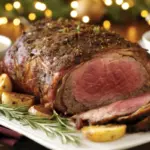
Easy Prime Rib Roast Oven Recipe for Special Occasions
- Total Time: 3-4 hours
- Yield: 6–8 servings 1x
Description
Master restaurant-quality prime rib right in your oven with this foolproof guide. Learn the exact oven temperature, timing, and seasoning method to achieve a perfectly juicy, tender, and flavorful prime rib roast every time.
Ingredients
- 1 (4-5 lb) bone-in or boneless prime rib roast
- 2 tbsp olive oil or softened butter
- 1 tbsp kosher salt
- 1 tbsp freshly cracked black pepper
- 2 tsp garlic powder
- 1 tsp onion powder
- 1 tbsp fresh rosemary or thyme (optional)
- 4 garlic cloves, halved (optional)
- 1 onion, sliced (optional)
Instructions
- Prepare the Roast: Remove the roast from the refrigerator 1-2 hours before cooking to bring to room temperature. Pat completely dry.
- Season: Rub with olive oil or butter. Mix salt, pepper, garlic powder, and onion powder, then coat the roast evenly. Press herbs into the surface if using.
- Sear: Preheat oven to 450°F (230°C). Place roast fat-side up on a rack in a roasting pan. Roast uncovered for 20 minutes to sear the exterior.
- Slow Roast: Reduce oven to 325°F (165°C) and continue roasting until internal temperature reaches:
• Rare: 120–125°F
• Medium-rare: 130°F
• Medium: 135–140°F
Plan 15–20 minutes per pound, but always check with a thermometer. - Rest: Remove roast from oven, tent with foil, and rest for 25–30 minutes for juices to redistribute.
- Carve: Slice bones away, then cut across the grain into ½–1-inch slices. Serve with au jus or horseradish sauce.
Notes
Cooking Tip: Always use a reliable instant-read thermometer for accuracy. Store leftovers within 2 hours in airtight containers and consume within 3–4 days. Reheat gently in a 250°F oven with a splash of broth to keep it juicy.
- Prep Time: 15 minutes
- Cook Time: 2 hours
- Category: Main Course
- Method: Oven Roasting
- Cuisine: American
Nutrition
- Serving Size: 4 oz
- Calories: 330
- Sugar: 0g
- Sodium: 620mg
- Fat: 24g
- Saturated Fat: 10g
- Carbohydrates: 0g
- Fiber: 0g
- Protein: 28g
- Cholesterol: 85mg

